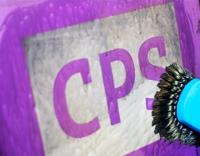 Add My Company
Add My Company
Sign In

There are three main steps to reclaiming a screen which if optimised will make screen reclaiming an efficient and effective process
Step 1 - Ink Removal
Assuming that the stencil is to be decoated and the screen reused for a new job, the first step is to remove as much of the ink as possible. The most effective way to do this is with a screen wash which allows the ink residue to be rinsed off with water rather than having to use multiple applications of a cleaning solvent.
Note - contact your local water authority to determine what effluent restrictions there maybe. Always refer to appropriate Product Data Sheet for advice on the safe handling of screen solvents.
Top tip
The CPS Colour Coded Brushes are perfect for applying screen wash as the soft fibres are resistant to solvents and the flagged fibre ends ensure good coverage.
Step 2 - Stencil Removal
There are several choices of stencil remover for Ultra Coat Emulsion; CPS Stencil Remover Concentrates that are diluted with water and Stencil Remover Paste, a ready to use gel. The choice of which one to use is dependent on personal preference, format, screen cleaning equipment and cost. For dip tanks use CPS Aquastrip 21.
Top tip
Autostrip works best if it is applied to wet screen using a soft brush. Apply to both sides of the screen. Never allow to dry in and make sure the brush is rinsed clean immediately after use. If the decoater is allowed to dry in then it is almost impossible to remove! Always rinse off stencil remover before using the high pressure gun as this prevents atomising the stripper which could be breathed in and/or lead to pinholes if allowed to fall on cleaned screens.
Link to Stencil Removers
Step 3 - Haze Removal
In most cases, a slight stain (ghost image or haze) remains on the mesh fibres after the stencil has been removed. The first step is to determine if it is an ink stain or a stencil/diazo stain. If the image is the same as the printed image then it is an ink stain, however, if it is a negative of the printed image, then it is a stencil stain.
Ink stains
The best way to remove an ink stain is with solvent, such as one of the screen washes.
Stencil stains
Stencil stains, especially diazo stains are best removed using a caustic haze remover.
Combination stains
In most cases though, the stain is a combination of both ink, stencil and Diazo and therefore haze removers that use both solvent and caustic are the most efficient
CPS offers three levels of Haze Remover (i) low caustic, (ii) medium caustic and (iii) high caustic.
The low caustic system Haze Remover HV is perfect for leaving on the mesh overnight and is used in conjunction with a screen wash to activate it prior to rinsing off.
The medium caustic is CPS Quick Haze, this is perfect for general day to day use and very effective UV Inks and water based pigment and dye inks.
The high caustic Fast Acting Haze Remover is a one pot product and is designed for use with really stubborn stains. Caution - do not leave Fast Acting Haze Remover on the mesh for more than a few minutes, otherwise it will damage the fibres.
Before using the high pressure gun. Always wear personal protective clothing when using caustic haze removers and refer to the appropriate Safety Data Sheet before use.
Top tip
Always first rinse the haze removal product off the screen using a low pressure spray and do not allow the screen to dry before using the high pressure gun. Always wear personal protective clothing when using caustic haze removers and refer to the appropriate Safety Data Sheet before use.
For more information on How To Reclaim Emulsion Screens talk to CPS - Chemical Products and Services
Enquire Now
More related to How To Reclaim Emulsion Screens
List your company on FindTheNeedle.
